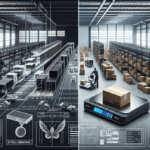FreightSnap vs NTEP Certified Scales with Integrated Dimensioning
In the logistics industry, accurately measuring the weight and dimensions of parcels is crucial for efficient shipping and precise billing. Two prominent tools in this arena are FreightSnap and NTEP certified scales with integrated dimensioning. This article offers an in-depth comparison of these solutions, assisting businesses in selecting the optimal tool for their specific needs.
Understanding the Basics of FreightSnap and NTEP Certified Scales
What is FreightSnap?
FreightSnap is an advanced dimensioning tool that leverages 3D cameras and sophisticated software to capture the height, width, and length of parcels. This data is then utilized to calculate weight and shipping costs automatically. FreightSnap is praised for its user-friendly interface and minimal need for operator intervention, making it ideal for businesses with high-volume shipping operations.
What are NTEP Certified Scales?
NTEP certified scales with integrated dimensioning combine digital weighing scales with measuring platforms to determine both weight and size. Certified by the National Type Evaluation Program (NTEP), these scales adhere to stringent accuracy and reliability standards, making them suitable for businesses handling larger and heavier parcels. The certification ensures compliance with regulatory requirements, which is essential for industries where precise measurements are legally mandated.
Both FreightSnap and NTEP certified scales enhance operational efficiency by providing accurate measurements, thereby reducing shipping errors and associated costs. Integration with leading shipping software further streamlines the shipping process. Businesses must evaluate their specific requirements and shipping volumes to determine which tool best aligns with their operational goals.
Key Differences Between FreightSnap and NTEP Certified Scales
Measurement Methodologies
The primary difference between FreightSnap and NTEP certified scales lies in their approach to measurement. FreightSnap employs automated 3D scanning technology, reducing the need for manual input. In contrast, NTEP certified scales use traditional weighing methods combined with manual measurements, which may require more operator involvement.
Accuracy and Reliability
While both tools offer high precision, FreightSnap achieves dimensional accuracy within 0.2 inches, suitable for most shipping needs. NTEP certified scales, on the other hand, maintain a margin of error of 0.5% or less, providing superior accuracy for heavy and large parcels where exact measurements are critical.
Functionalities and Features
FreightSnap offers additional functionalities such as image capture, barcode generation, and seamless integration with major shipping software, enhancing overall workflow. NTEP certified scales focus primarily on accurate weight measurement and may lack the extended features available in FreightSnap.
Detailed Comparison of FreightSnap and NTEP Certified Scales
Accuracy
Both FreightSnap and NTEP certified scales deliver high-precision measurements. However, NTEP certified scales are typically preferred for scenarios requiring exact weight measurements, especially for large and hefty items. According to the National Institute of Standards and Technology (NIST), NTEP certification ensures that scales meet rigorous accuracy standards essential for compliance and billing.
Operational Speed
FreightSnap excels in operational speed due to its automated measurement process, which minimizes the need for manual handling. This is particularly advantageous for businesses processing large volumes of shipments daily. In contrast, NTEP certified scales require manual placement and measurement of each parcel, which can slow down the shipping process.
Cost Considerations
From a cost perspective, FreightSnap is generally more affordable, with investments ranging between $5,000 and $15,000. This cost-effectiveness is attributed to its automated systems and minimal hardware requirements. NTEP certified scales, however, come with a higher price tag, ranging from $15,000 to $50,000, reflecting their enhanced accuracy and regulatory compliance.
Integration Capabilities
FreightSnap seamlessly integrates with popular shipping platforms like UPS, FedEx, and USPS, facilitating streamlined shipping operations. On the other hand, integrating NTEP certified scales may require additional software or hardware investments, potentially increasing overall costs and implementation complexity.
Which One is More Accurate: FreightSnap or NTEP Certified Scales?
Both FreightSnap and NTEP certified scales offer high levels of accuracy, but they cater to different needs. NTEP certified scales are generally more accurate for measuring the weight of large and heavy parcels, making them indispensable in industries where precise measurements are legally required.
Conversely, FreightSnap provides comprehensive measurements by capturing both dimensions and weight, which is beneficial for optimizing packaging and shipping costs. This dual functionality is particularly advantageous for businesses aiming to enhance packaging efficiency and reduce shipping expenses.
Additionally, FreightSnap's versatility allows it to be used in various settings, including warehouses, distribution centers, and shipping facilities. In contrast, NTEP certified scales are typically employed in specialized environments such as the food industry or for legal trade purposes where regulatory compliance is mandatory.
Advantages and Disadvantages of Using FreightSnap for Dimensioning
Advantages:
- Highly automated, increasing efficiency for high-volume shipping operations.
- Provides accurate dimensional measurements with minimal operator input.
- Seamlessly integrates with various shipping software and systems, reducing errors.
- Offers real-time data and analytics for informed decision-making and operational optimization.
Disadvantages:
- May have accuracy limitations for heavy parcels compared to NTEP certified scales.
- Requires additional validation to ensure measurement accuracy in certain scenarios.
- Less effective for irregularly shaped packages, potentially necessitating manual measurements.
- Initial investment in equipment and software may not be cost-effective for low-volume businesses.
Pros and Cons of Using NTEP Certified Scales for Dimensioning
Pros:
- Exceptional accuracy for heavy and large parcels, ensuring precise billing and compliance.
- Certified by regulatory bodies like the NIST, ensuring reliability and compliance.
- Advanced features such as automatic calibration and data logging enhance operational efficiency.
Cons:
- Slower operation requiring more manual input compared to automated solutions like FreightSnap.
- Higher implementation costs, especially when integrating with existing shipping software.
- Not ideal for irregularly shaped or oversized items, which may require alternative dimensioning methods.
- Potential durability issues, with some users reporting equipment failures over extended use.
How to Choose the Right Dimensioning Tool for Your Business: A Comprehensive Guide
Selecting the appropriate dimensioning tool involves evaluating several key factors:
- Shipping Volume: High-volume shippers may benefit more from FreightSnap's automation, while lower volumes might find NTEP scales manageable.
- Parcel Weight and Size: Businesses handling larger, heavier parcels should prioritize NTEP certified scales for enhanced accuracy.
- Budget: FreightSnap offers a more cost-effective solution for many businesses, whereas NTEP scales require a larger initial investment.
- Accuracy Requirements: For precision in legal billing or compliance, NTEP certified scales are preferable.
- Integration Needs: Ensure the tool integrates smoothly with your existing shipping software and systems to facilitate seamless operations.
Cost Comparison: FreightSnap vs NTEP Certified Scales with Integrated Dimensioning
FreightSnap is generally the more affordable option, with pricing typically ranging from $5,000 to $15,000. This affordability is due to its automated nature and minimal hardware requirements, making it suitable for businesses with high shipping volumes.
In contrast, NTEP certified scales can cost between $15,000 and $50,000, depending on the features and certifications required. The higher cost is justified by their superior accuracy, regulatory compliance, and durability, which are essential for industries where precise measurements are crucial.
Additionally, compliance with regulatory requirements can offset the initial investment in NTEP certified scales by preventing potential fines and ensuring accurate billing, which is vital for maintaining business integrity and customer trust.
Customer Reviews: What Users Are Saying About FreightSnap and NTEP Certified Scales
Users of FreightSnap often highlight its ease of use and high level of automation, which significantly accelerates their shipping processes. The seamless integration with existing shipping software systems is also highly appreciated, fostering a more streamlined workflow.
However, some users have reported occasional accuracy discrepancies with FreightSnap, particularly when measuring very heavy parcels. These instances typically require additional validation to ensure measurement precision, though customer support teams have been proactive in addressing such issues.
Users of NTEP certified scales commend their outstanding accuracy and compliance with legal billing standards, which are critical for industries requiring exact measurements for regulatory purposes. Nevertheless, some users have encountered durability issues, such as equipment malfunctions after prolonged use or hardware failures, indicating a need for robust maintenance practices.
Integrating Dimensioning Technology into Your Logistics Operations: Best Practices
To effectively incorporate dimensioning technology into your logistics operations, consider the following best practices:
- Select the Right Tool: Choose a dimensioning tool that aligns with your business requirements, shipping volume, and accuracy needs.
- Comprehensive Training: Ensure your staff is thoroughly trained on how to use the dimensioning tool to maximize efficiency and accuracy.
- Validate Measurements: Regularly validate the accuracy of your dimensioning tools to maintain compliance and billing precision.
- Ensure Software Compatibility: Verify that the dimensioning tool is compatible with your existing software and hardware systems to facilitate seamless integration.
- Regular Maintenance: Schedule routine maintenance and updates to keep your dimensioning technology functioning optimally.
- Conduct a Cost-Benefit Analysis: Evaluate the costs versus the benefits of implementing new dimensioning technology to ensure it justifies the investment.
How to Improve Efficiency and Accuracy in Your Shipping Process with Dimensioning Tools
Implementing effective dimensioning tools can significantly enhance both efficiency and accuracy in your shipping operations. Consider the following strategies:
- Adopt a dimensioning tool that automates measurements to reduce manual input and minimize errors.
- Integrate your dimensioning tool with your shipping software to streamline data flow and eliminate redundant tasks.
- Provide comprehensive training to your staff to ensure proficient use of the dimensioning tools.
- Regularly maintain and calibrate your dimensioning equipment to ensure ongoing accuracy.
- Utilize real-time data and analytics from your dimensioning tools to monitor performance and identify areas for improvement.
- Implement best practices for package handling and measurement to minimize inaccuracies.
Future Trends in Dimensioning Technology: What to Expect in the Coming Years
Dimensioning technology is rapidly advancing, driven by innovations in automation, artificial intelligence, and system integration. Anticipate the following trends in the near future:
- Increased Automation: Enhanced automation features will further reduce the need for manual input, increasing speed and reducing errors.
- Artificial Intelligence Integration: AI will enhance the accuracy and adaptability of dimensioning tools, enabling better handling of irregularly shaped packages.
- Greater Integration with Other Systems: Dimensioning tools will more seamlessly integrate with barcode scanners, RFID technology, and other logistics systems for comprehensive supply chain management.
- Enhanced Data Analytics: Advanced analytics will provide deeper insights into shipping patterns, helping businesses optimize their logistics operations.
- Improved Mobility: Portable dimensioning solutions will become more prevalent, allowing for flexible use across different locations and shipping environments.
How to Implement a Dimensioning Solution with Minimum Disruption to Your Business
Implementing a dimensioning solution with minimal disruption requires careful planning and strategic execution. Follow these steps to ensure a smooth transition:
- Assess Your Needs: Evaluate your current shipping processes and identify areas where dimensioning tools can add value.
- Choose the Right Tool: Select a dimensioning solution that fits your specific business requirements and integrates well with your existing systems.
- Plan the Implementation: Schedule the implementation during a period of lower shipping volume to minimize operational disruptions.
- Train Your Staff: Provide comprehensive training to your employees to ensure they are comfortable and proficient with the new technology.
- Test the System: Conduct thorough testing of the dimensioning tool to identify and resolve any issues before full-scale deployment.
- Monitor and Adjust: After implementation, continuously monitor the performance of the dimensioning tool and make adjustments as needed to optimize its use.
In conclusion, selecting the right dimensioning tool is essential for accurate shipping cost billing and enhanced operational efficiency. By carefully evaluating the advantages and disadvantages of FreightSnap and NTEP certified scales, and adhering to best practices for implementation and maintenance, your business can achieve a streamlined and precise shipping process.






















